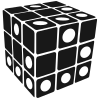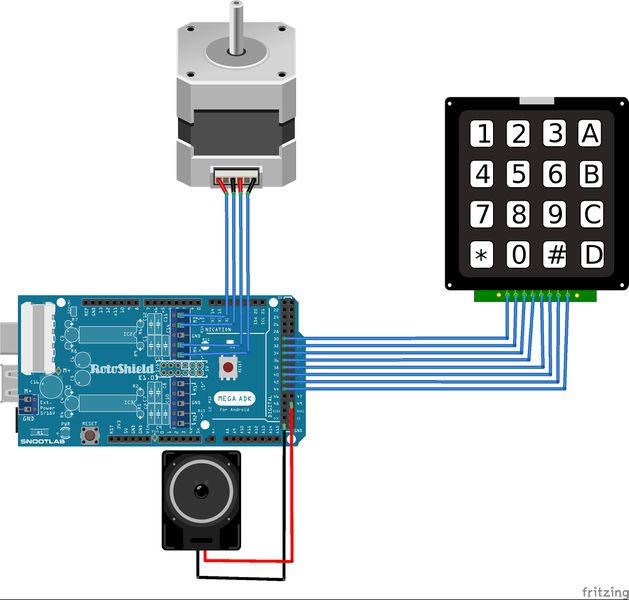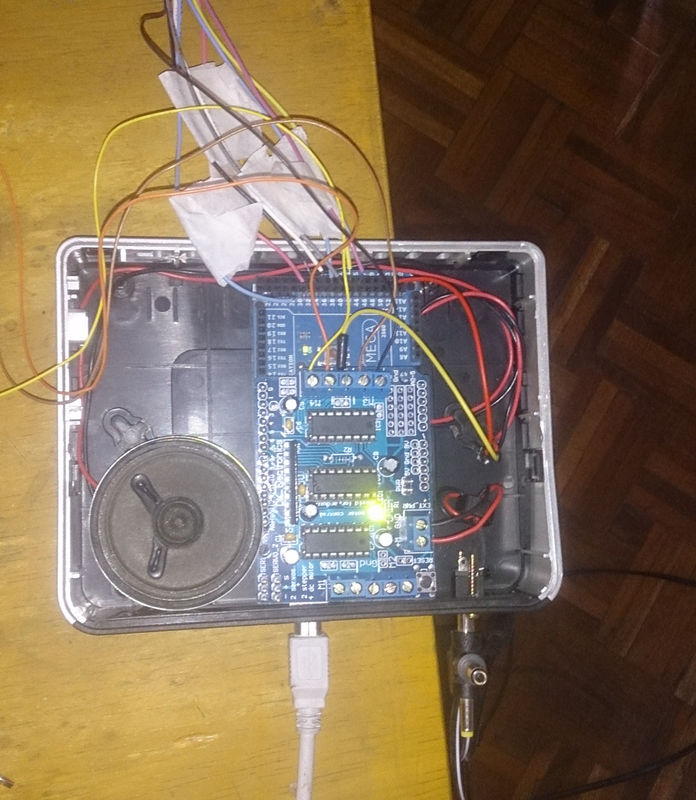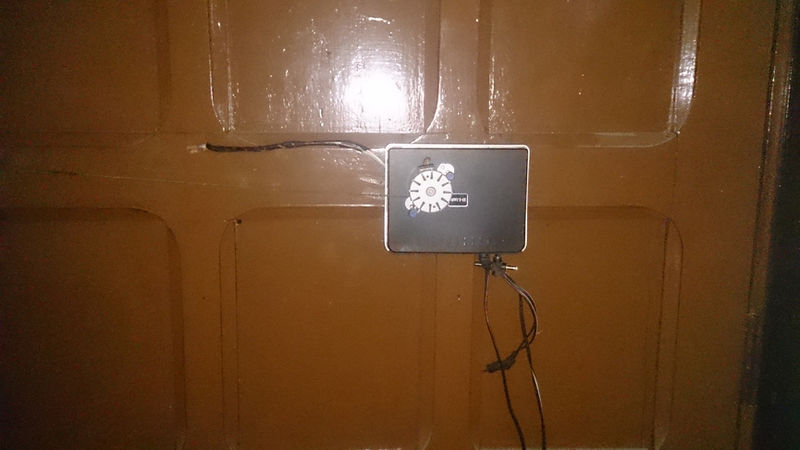Diferencia entre revisiones de «Abrepuertas»
Sin resumen de edición |
(jo) |
||
| Línea 41: | Línea 41: | ||
byte rowPins[ROWS] = {30, 32, 34, 36}; //connect to the row pinouts of the keypad | byte rowPins[ROWS] = {30, 32, 34, 36}; //connect to the row pinouts of the keypad | ||
byte colPins[COLS] = {38, 40, 42, 44}; //connect to the column pinouts of the keypad | byte colPins[COLS] = {38, 40, 42, 44}; //connect to the column pinouts of the keypad | ||
Password password = Password( " | Password password = Password( "98125" ); | ||
//initialize an instance of class NewKeypad | //initialize an instance of class NewKeypad | ||
Keypad customKeypad = Keypad(makeKeymap(hexaKeys), rowPins, colPins, ROWS, COLS); | Keypad customKeypad = Keypad(makeKeymap(hexaKeys), rowPins, colPins, ROWS, COLS); | ||
| Línea 304: | Línea 304: | ||
[[File:DSC 0006.JPG|center|800x600px|DSC 0006.JPG]] | [[File:DSC 0006.JPG|center|800x600px|DSC 0006.JPG]] | ||
<span style="font-size:large">'''Referencias'''</span> | <span style="font-size:large">'''Referencias'''</span> | ||
Revisión del 01:46 7 sep 2014
En el HL no todos cuentan con una llave para ingresar a la casa, esto resuelve un poco este problema.
Armado
Tambien en la red hay varios ejemplos de tipos de armado con diferentes funciones, en nuestro caso usamos un motor DC de una impresora vieja que teniamos.
Usamos lo siguiente:
- Motor DC paso a paso (impresora)
- Key 4x4
- Arduino Mega ADK
- Arduino motor shield L293D
- Bocina vieja de CPU
Código
El código tambien esta en GitHub
como pueden observar para este proyecto usamos varias fuentes de código y las unimos para obtener nuestro producto que aun le faltan hacer algunas modificaciones.
#include <Keypad.h>
#include <Password.h>
#include <AFMotor.h>
const byte ROWS = 4; //four rows
const byte COLS = 4; //four columns
//define the cymbols on the buttons of the keypads
char hexaKeys[ROWS][COLS] = {
{'1','2','3','U'},
{'4','5','6','D'},
{'7','8','9','F'},
{'C','0','H','E'}
};
byte rowPins[ROWS] = {30, 32, 34, 36}; //connect to the row pinouts of the keypad
byte colPins[COLS] = {38, 40, 42, 44}; //connect to the column pinouts of the keypad
Password password = Password( "98125" );
//initialize an instance of class NewKeypad
Keypad customKeypad = Keypad(makeKeymap(hexaKeys), rowPins, colPins, ROWS, COLS);
double passos_total = 512; //Numero de passos para 1 rotacao total
int porta_motor = 2; //1 para motor em M1/M2 e 2 para motor em M3/M4
int angulo = 90; //Angulo de rotacao do eixo
double numero_de_passos = 0; //Armazena o numero de passos que o motor vai girar
AF_Stepper arduino(passos_total, porta_motor); //Define os parametros do motor
#define NOTE_B0 31
#define NOTE_C1 33
#define NOTE_CS1 35
#define NOTE_D1 37
#define NOTE_DS1 39
#define NOTE_E1 41
#define NOTE_F1 44
#define NOTE_FS1 46
#define NOTE_G1 49
#define NOTE_GS1 52
#define NOTE_A1 55
#define NOTE_AS1 58
#define NOTE_B1 62
#define NOTE_C2 65
#define NOTE_CS2 69
#define NOTE_D2 73
#define NOTE_DS2 78
#define NOTE_E2 82
#define NOTE_F2 87
#define NOTE_FS2 93
#define NOTE_G2 98
#define NOTE_GS2 104
#define NOTE_A2 110
#define NOTE_AS2 117
#define NOTE_B2 123
#define NOTE_C3 131
#define NOTE_CS3 139
#define NOTE_D3 147
#define NOTE_DS3 156
#define NOTE_E3 165
#define NOTE_F3 175
#define NOTE_FS3 185
#define NOTE_G3 196
#define NOTE_GS3 208
#define NOTE_A3 220
#define NOTE_AS3 233
#define NOTE_B3 247
#define NOTE_C4 262
#define NOTE_CS4 277
#define NOTE_D4 294
#define NOTE_DS4 311
#define NOTE_E4 330
#define NOTE_F4 349
#define NOTE_FS4 370
#define NOTE_G4 392
#define NOTE_GS4 415
#define NOTE_A4 440
#define NOTE_AS4 466
#define NOTE_B4 494
#define NOTE_C5 523
#define NOTE_CS5 554
#define NOTE_D5 587
#define NOTE_DS5 622
#define NOTE_E5 659
#define NOTE_F5 698
#define NOTE_FS5 740
#define NOTE_G5 784
#define NOTE_GS5 831
#define NOTE_A5 880
#define NOTE_AS5 932
#define NOTE_B5 988
#define NOTE_C6 1047
#define NOTE_CS6 1109
#define NOTE_D6 1175
#define NOTE_DS6 1245
#define NOTE_E6 1319
#define NOTE_F6 1397
#define NOTE_FS6 1480
#define NOTE_G6 1568
#define NOTE_GS6 1661
#define NOTE_A6 1760
#define NOTE_AS6 1865
#define NOTE_B6 1976
#define NOTE_C7 2093
#define NOTE_CS7 2217
#define NOTE_D7 2349
#define NOTE_DS7 2489
#define NOTE_E7 2637
#define NOTE_F7 2794
#define NOTE_FS7 2960
#define NOTE_G7 3136
#define NOTE_GS7 3322
#define NOTE_A7 3520
#define NOTE_AS7 3729
#define NOTE_B7 3951
#define NOTE_C8 4186
#define NOTE_CS8 4435
#define NOTE_D8 4699
#define NOTE_DS8 4978
#define melodyPin 50
//Mario main theme melody
int melody[] = {
NOTE_E7, NOTE_E7,
};
//Mario main them tempo
int tempo[] = {
12, 12,
};
//
//Underworld melody
int underworld_melody[] = {
NOTE_C4, NOTE_C5,
};
//Underwolrd tempo
int underworld_tempo[] = {
12, 12,
};
void setup(){
arduino.setSpeed(10);
Serial.begin(9600);
pinMode(50, OUTPUT);//buzzer
}
void loop(){
char customKey = customKeypad.getKey();
if (customKey != NO_KEY){
Serial.print("tecla ");
Serial.println(customKey);
delay(10);
switch (customKey) {
case 'E': checkPassword(); delay(1); break; // Enter password
case 'C': password.reset(); delay(1); break; // Clear buffer
default: password.append(customKey); delay(1); // add key to password
}
}
}
void checkPassword() {
if (password.evaluate()) { // if password is right open box
Serial.println("Accepted");
delay(10);
password.reset(); delay(1);
sing(1);
CMotores();
} else {
Serial.println("Denied"); // if passwords wrong keep box locked
delay(10);
password.reset(); delay(1);
sing(2);
}
}
void CMotores(){
numero_de_passos = angulo / (360 / passos_total);
//Mostra no serial monitor o numero de passos calculados
Serial.println(numero_de_passos);
//Move o motor. Use FORWARD para sentido horario,
//BACKWARD para anti-horario
arduino.step(numero_de_passos, FORWARD, SINGLE);
arduino.release();
delay(2000);
}
int song = 0;
void sing(int s){
// iterate over the notes of the melody:
song = s;
if(song==2){
Serial.println(" 'Underworld Theme'");
int size = sizeof(underworld_melody) / sizeof(int);
for (int thisNote = 0; thisNote < size; thisNote++) {
// to calculate the note duration, take one second
// divided by the note type.
//e.g. quarter note = 1000 / 4, eighth note = 1000/8, etc.
int noteDuration = 1000/underworld_tempo[thisNote];
buzz(melodyPin, underworld_melody[thisNote],noteDuration);
// to distinguish the notes, set a minimum time between them.
// the note's duration + 30% seems to work well:
int pauseBetweenNotes = noteDuration * 1.30;
delay(pauseBetweenNotes);
// stop the tone playing:
buzz(melodyPin, 0,noteDuration);
}
}else{
Serial.println(" 'Mario Theme'");
int size = sizeof(melody) / sizeof(int);
for (int thisNote = 0; thisNote < size; thisNote++) {
// to calculate the note duration, take one second
// divided by the note type.
//e.g. quarter note = 1000 / 4, eighth note = 1000/8, etc.
int noteDuration = 1000/tempo[thisNote];
buzz(melodyPin, melody[thisNote],noteDuration);
// to distinguish the notes, set a minimum time between them.
// the note's duration + 30% seems to work well:
int pauseBetweenNotes = noteDuration * 1.30;
delay(pauseBetweenNotes);
// stop the tone playing:
buzz(melodyPin, 0,noteDuration);
}
}
}
void buzz(int targetPin, long frequency, long length) {
long delayValue = 1000000/frequency/2; // calculate the delay value between transitions
//// 1 second's worth of microseconds, divided by the frequency, then split in half since
//// there are two phases to each cycle
long numCycles = frequency * length/ 1000; // calculate the number of cycles for proper timing
//// multiply frequency, which is really cycles per second, by the number of seconds to
//// get the total number of cycles to produce
for (long i=0; i < numCycles; i++){ // for the calculated length of time...
digitalWrite(targetPin,HIGH); // write the buzzer pin high to push out the diaphram
delayMicroseconds(delayValue); // wait for the calculated delay value
digitalWrite(targetPin,LOW); // write the buzzer pin low to pull back the diaphram
delayMicroseconds(delayValue); // wait again or the calculated delay value
}
}
Resultado
Unas fotos del trabajo
Referencias
http://blog.filipeflop.com/motores-e-servos/controle-motor-dc-arduino-motor-shield.html




